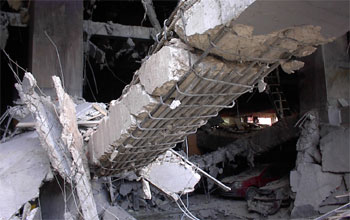Multimedia Gallery
Making Buildings Stronger (Image 3)
Making Buildings Stronger (Image 3)
Reinforced concrete structures were critical to the survival of hundreds when the car bomb struck the El Nogal social club in Bogota, Columbia, on Feb. 7, 2003.
.
While the devastation from a powerful 600-pound car bomb is obvious, the damage could have been far worse. Because engineers had designed the building to withstand the shaking of earthquakes, the structure was able to absorb much of the explosive force and did not collapse. When the blast struck, 750 people were in the building. However, because the building remained standing, more than 500 people survived unscathed and only 38 lost their lives. [One of four related images. See Next Image.]
More about this Image
El Nogal, composed of the 12-story structure and an adjacent, smaller four-story structure, was designed to withstand seismic shaking. Julio Ramirez and Mete Sozen of Purdue University, Luis García of Universidad de Los Andes, Colombia, and Santiago Pujol of WJE Associates studied El Nogal to determine how a modern building designed to sustain earthquakes responds to an explosive blast. The researchers compared the Colombia event in February 2003 to a comparable event in Oklahoma City in April 1995, when the Murrah Federal Building (which was not designed for earthquakes) was eviscerated by an enormous truck bomb placed there by Timothy McVeigh.
For engineers, similar concerns apply to both earthquakes and explosions, and engineers intend to use seismic design concepts to produce structures that address both threats. Specifically, the structures must be redundant (able to retain integrity after a component fails) and tough (able to retain integrity through cycles of stress). Researchers found that reinforcing details, which were integrated into the structure of El Nogal and were required by Colombia's seismic code were critical in preventing total collapse of the building. Such details helped minimize a tragedy not foreseen by engineers who designed the structure to withstand only the forces of an earthquake.
The study was supported by National Science Foundation grant CMS 03-27753, awarded to Julio Ramirez.
Credit: Mete Sozen and Julio Ramirez, Purdue University School of Civil Engineering
Images and other media in the National Science Foundation Multimedia Gallery are available for use in print and electronic material by NSF employees, members of the media, university staff, teachers and the general public. All media in the gallery are intended for personal, educational and nonprofit/non-commercial use only.
Images credited to the National Science Foundation, a federal agency, are in the public domain. The images were created by employees of the United States Government as part of their official duties or prepared by contractors as "works for hire" for NSF. You may freely use NSF-credited images and, at your discretion, credit NSF with a "Courtesy: National Science Foundation" notation.
Additional information about general usage can be found in Conditions.
Also Available:
Download the high-resolution TIF version of the image. (1.6 MB)
Use your mouse to right-click (Mac users may need to Ctrl-click) the link above and choose the option that will save the file or target to your computer.



